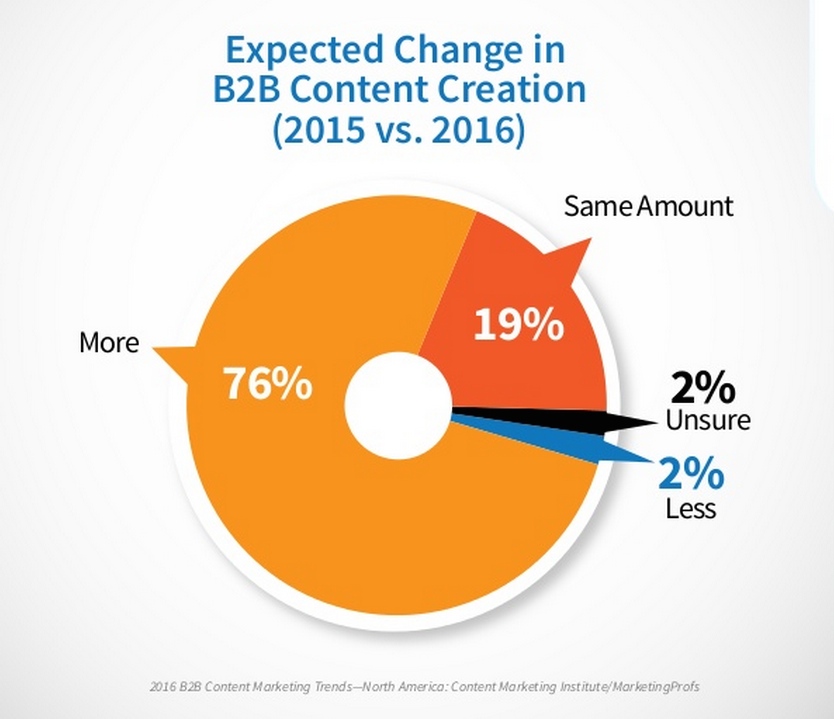This blog post is the first in a series responding to findings in the new study on B2B marketing content from the Content Marketing Institute and MarketingProfs, and sponsored by Brightcove.
The B2B Content Marketing report shows, not surprisingly, that B2B marketers are increasingly focused on driving revenue. As we have discussed in previous blog posts, CMOs are being asked to deliver marketing that measurably affects the company’s bottom line. What is compelling in this new study by CMI and MarketingProfs, is how marketers are looking to achieve this goal.
One eye-opening statistic is that 76% of the respondents reported they plan to produce more content in 2016. Our hope is that those same respondents are part of the 72% who noted creating more engaging content is a top priority; as well as the 65% who are looking to understand what content is effective - and what isn’t.
The concern with prioritizing the creation of more content is that it creates a digital cacophony of chatter that acts as a barrier to finding useful content. When Sirius Decisions reported that 67% of the buyer’s journey is conducted through digital channels, many misread this as a call to increase content output. We highly recommend marketers concentrate on more engaging, more effective content that can be used throughout the customer journey.
Video has proven to be one of the most effective content formats for marketers. The reasoning is twofold: 1) it creates a significant increase in organic search traffic, in time onsite, and in conversion rates, and 2) it connects with viewers at their emotional core in a way that allows them to identify with, and fully consume, the meaning of your content. For those reasons and more, Brightcove says Video Moves. It moves people, it has moved history, and for marketers, it moves business.
The key questions raised in the new B2B Content Marketing report then, are how can marketers create more engaging video content and how can they understand what content is effective. In the rest of this B2B Content Marketing blog series, we’ll explore tactical best practices. For now, an overview of considerations for video throughout the customer journey:
For Awareness:
- Types of video content: explainers, thought leadership, stats and facts
- Create shorter, high quality videos
- Create teaser versions of your onsite videos for use in social media to draw viewers to YOUR site
- Place social sharing buttons in your video player
For Engagement
- Types of video: how to, product demos, customer success stories
- Create longer, detailed content for researchers
- Gate videos with lead forms mid or post roll
- Use video in email campaigns for increased open rates
- Integrate your video platform with your MAP and CRM for seamless marketing and sales communication, and a holistic view of your individual customers and prospects
For Conversion
- Types of video: product-specific content
- Create shoppable video players that unite your multimedia and e-commerce
- Integrate with your CRM
- Place video next to the order or booking module
For Retention
- Types of video: high-quality product videos (for upsells, return customers)
- Create “related video” pathways through playlists, video portals and/or links at the end of the selected videos
- Tie video to your website personalization
- Integrate your video platform with your MAP
For Advocacy
- Type of video: customer testimonials, customer care and support
- Offer option to customers and advocates to post UGC on your site and social
- Attach to a social community
When looking to see what content is effective, online video natively offers metrics including what was watched, how long it was watched and from where. Unlike a downloadable PDF that only lets you know it was downloaded, when someone clicks on a video you instantly know how much of the content was consumed and what other video content was consumed. This information alone is powerful. When you integrate those metrics into a marketing automation platform, you are able to build a profile of the individual viewer creating a holistic view of that person’s consumed content - what was of interest and what was not - and effectively nurture that lead through the customer journey with the right content at the right time.
In 2014, we conducted research with Aberdeen Group that demonstrated why video marketers are ahead of the curve in using marketing analytics:
- 64% of marketers using video can track how a specific asset is performing (vs 28% non-video users)
- 43% of marketers using video can capture content metrics across all channels (vs 16% non-video users)
- 38% of marketers using video have a process to track engagement (vs 12% non-video users)
This ability to track marketing effectiveness through video leads to increased revenue impact. A similar 2015 Aberdeen Group report noted that marketers using video outpace non-users by 63% in increasing their contribution to revenue year-over-year.
Thus our take away from the B2B Content Marketing report is that video is a highly valuable tool for marketers in 2016 and beyond. In later posts in this series, we’ll offer tips and tricks and insight into how marketers can meet their content goals with video.
Read the 2015 Aberdeen Group report on video marketing


